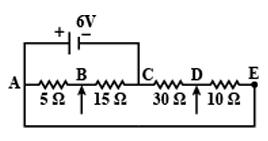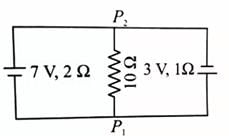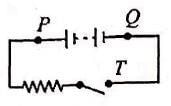Test: Kirchhoff’s Rules & Wheatstone Bridge (December 6) - NEET MCQ
10 Questions MCQ Test - Test: Kirchhoff’s Rules & Wheatstone Bridge (December 6)
In a wheatstone bridge if the battery and galvanometer are interchanged then the deflection in galvanometer will
In a Wheatstone’s network, P = 2Ω, Q = 2Ω, R = 2Ω and S = 3Ω. The resistance with which S is to be shunted in order that the bridge may be balanced is
| 1 Crore+ students have signed up on EduRev. Have you? Download the App |
Four resistances of 3Ω, 3Ω, 3Ω and 4Ω respectively are used to form a Wheatstone bridge. The 4Ω resistance is short circuited with a resistance R in order to get bridge balanced. The value of R will be
Four resistors are connected as shown in the figure.

A 6V battery of negligible resistance, is connected across terminals A and C. The potential difference across terminals B and D will be
A circuit has a section ABC if the potential at point A, B and C are V1, V2 and V3 respectively, calculate the potential at point O is
The potential difference between A and B in figure is

A current of 6A enters one corner P of an equilateral triangle PQR having 3 wires of resistances 2 Ω each and leaves by the corner R. Then the current I1 and I2 are

A 7V battery with internal resistance 3Ω and 3V battery with internal resistance 10mega are connected to a 10Ω resistors as shown in figure, the current in 10Ω resistor is

In the given circuit the potential at point B is zero, the potential at points A and D will be

A battery, an open switch and a resistor are connected in series as shown in figure.

Consider the following three statements concerning the circuit. A voltmeter will read zero if it is connected across points
(i) P and T
(ii) P and Q
(iii) Q and T
Which one of the above is/are true?





























